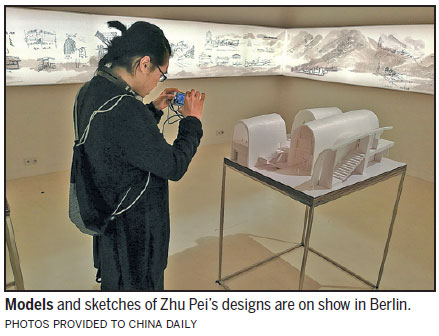
Named one of the "five greatest architects under 50" by the Huffington Post, Zhu Pei is credited with offering solutions to the challenges of ongoing urbanization in China.
An exhibition of five works currently under construction by Zhu is underway at Berlin's Aedes Architecture Forum through May 18, offering the European design community an insight into the work process of one of China's leading contemporary architects.
"Chinese architects are increasingly becoming the ambassadors of Chinese culture and art," Li Gang, from the cultural department at the Chinese embassy in Berlin, says.
The exhibition showcases models and sketches of Zhu's plans for the Yang Liping Performing Arts Center and the Museum of Contemporary Art, both in Dali, Yunnan province, the Shijingshan Cultural Center in Beijing, the Shou County Culture and Art Center in Anhui province and the Museum of Imperial Kiln in Jingdezhen, Jiangxi province.
Aedes curator Eduard Kogel says Zhu's work process is distinctive as he rarely uses computer modeling, instead, he relies on ink paintings and uses clay and plastic foam models to bring his ideas to life. Zhu also generally arrives at a site without a form in mind, allowing the landscape and culture of the area to inform his design.
"I don't know any other architect who works in this way," Kogel says.
"He develops his ideas out of the context of the area and its people, as well as the surrounding. This is necessary because we are challenged everywhere around the world by urban sprawl and the problems that come with that, like mobility, traffic and pollution. So you have to find solutions that integrate nature and sustainability.
"Zhu Pei does this. He finds solutions that are based on the environment and then brings them into artificial architectural forms."
Zhu's museum in Jingdezhen will take the form of several cavernous, cylindrical structures reminiscent of clay pottery kilns, inspired by the region's historical status as a porcelain hub.
Some 2,000 kilometers away, among the mountains and lakes of Dali, his performing arts center's canopy-like roof will hover over undulating structures that draw from the region's hilly topography.
Zhu is at the forefront of a new wave of contemporary Chinese architects that the West is beginning to notice.
Soft-spoken yet direct, Zhu is scathing about the prefabricated tower blocks that have sprung up across new cities during China's rapid urbanization, but optimistic about the next generation of architects in his country.
"China is in a very special moment in terms of architecture and urbanization," Zhu says.
"We have had a huge amount of urban development in the last 30 years as well as urban sprawl. Now designers are taking into account sustainability, nature and quality of life in architecture."
Around the turn of the century, a set of architects broke away from China's large national planning institutes to set up independent firms including Zhu's Studio Pei-Zhu, Wang Hui's Urbanus and Zhang Ke's Standard Architecture.
Several were educated abroad - Zhu at the University of California, Berkeley, and Zhang at Harvard University - and marry the latest in contemporary architecture technique and theory with an understanding of Chinese culture and philosophy.
"Europe and China are facing the same challenges and we can learn from each other," Zhu says.
"One is that contemporary architecture often lacks the local DNA. You have to be conscious that, for example, if you bring a Mediterranean-style building to China it might not work. In the same way if you bring a traditional Chinese building to Europe it might not work."
He adds: "I always ask, how can contemporary architecture root itself into the soil it is built on? I always try and project the landscape of an area onto what I am making."
Zhu's creative process is traditional. He often forgoes computer-generated modeling for hand drawn ink paintings, a throwback to classical Chinese landscape artists, who would spend time meditating in natural setting before leaving and painting from memory.
Zhu says a sensitivity to nature and a site's cultural background is paramount to achieving a structure that compliments any given space.
"My exhibition here in Berlin brings some new ideas, some contemporary thinking about how to deal with current urban architectural problems," he says. "At the same moment I have included Chinese philosophy and principles about the role of nature which can be really helpful today."
Aedes founder Kristin Feireiss has been exhibiting Chinese architects for the past 17 years. She says she was motivated to share their work when a new generation of architects emerged at the turn of the century.
"Their works form the basis for the next independent working architecture generation. Zhu Pei is one of the leading protagonists of this young, talented and self-confident new movement of Chinese architecture," she says.
angus@mail.chinadailyuk.com
